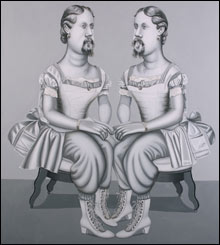
THE CHESTERLY SISTERS: Hannah Barrett
mixes and matches anatomy, but the results
ain’t transgressive. |
“The Secret Society,” Jamaica Plain artist Hannah Barrett’s show of gender-bending grisaille paintings at Howard Yezerski Gallery, dices and recombines Civil War–era photographic portraits to invent a parade of curious dames, viscounts, lords, and duchesses. The Chesterly Sisters (2007) depicts mirror-image twins in satiny gowns perched next to each other on a bench. Their goatees, large hands, and broad shoulders suggest they’re gentlemen. Or cross-dressing gentlemen. But their hairdos, attire, and wasp waists suggest they’re ladies. Or bearded ladies. Barrett mixes and matches anatomy and reflects it with a funhouse-mirror eye so that typical gender cues turn all slippery.She’s been playing this intriguing game for years now. The method may remain consistent, but her meaning seems to shift with her context. Previous mix-and-match paintings of her parents appeared to speak of how couples bond and parents’ attributes are recombined in their children. When she merged the features of a pair of married Harvard genetic scientists, creating a cyclops and a four-armed mutant, it seemed a comment on genetic engineering. This time she tours the 19th century, so the associations include P.T. Barnum’s fabulous freaks and suffragettes who sought equal rights as men.
Her painting and compositions are sharper than in that 2006 genetic-scientists series. And these characters are especially intriguing, fun and freaky. But they ain’t transgressive. Barrett is circling the edges of something big and untamed that includes gay marriage, women’s ability at science and math, and “pink hat” Sox fans. There’s more to tap here.
The Danforth Museum bills its Morton Bartlett exhibition as the first Boston-area show of the weirdo underground Boston dollmaker and photographer. He and his curious hand-crafted plaster children, which he photographed in narrative tableaux, appeared in Yankee magazine in 1962 but remained little-known until they were rediscovered after his death, in 1992.
The nine photos here have the look of children’s-clothing-store display windows gone wrong — specifically the eerie sexual charge shot through these scenes. In small black-and-white photos, a girl cries in what could be a classroom, a pair of sleepy girls lie together in bed, a little girl in a dress sits with her legs spread wagging her finger at a naughty dog. A recent color photo printed from Bartlett’s slides shows a perky clothed teen forcing an awkward smile as she stands with her legs jauntily apart holding a baton. Wink, wink. For good measure, one of the actual dolls is displayed.
The work here isn’t as incandescently weird as Bartlett gets (check out Marion Harris’s 1994 Bartlett book Family Found for gatherings of his naked, anatomically correct kid dolls), so the show winds up being a bit flat. At its most affecting, Bartlett’s art is a disconcerting combo of innocence, flirtation, and latent pedophilia. And the dolls’ expressiveness — irritation, anger, crying — creeps under your skin.